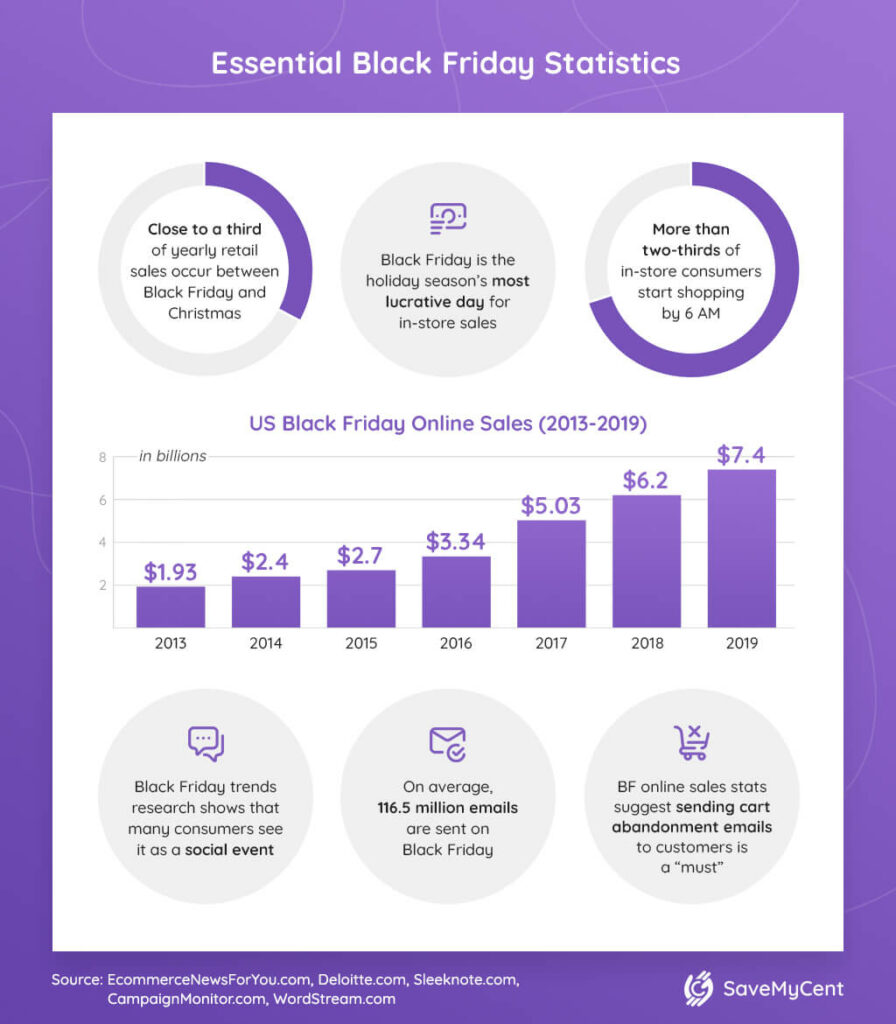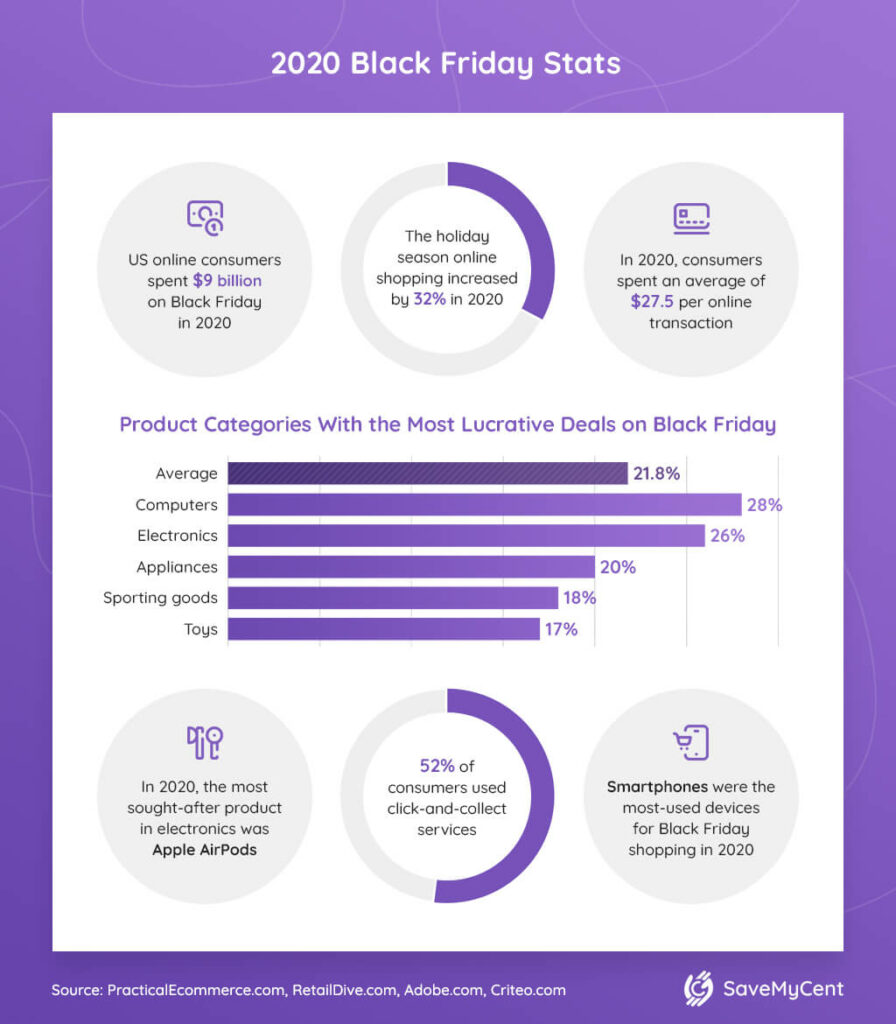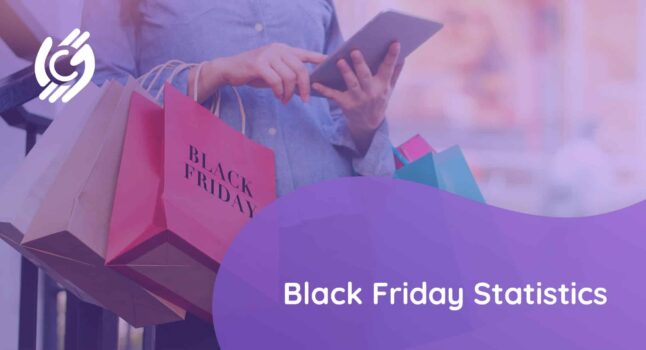For the first time, images of huge, lined-up crowds armed with excitement and promo leaflets didn’t travel the world on Black Friday 2020. Instead, the shopping holiday was preceded by uncertainty in the retail industry as the global pandemic didn’t allow for mass gatherings.
As you’ll learn from these Black Friday stats, this shopping holiday is tremendously important for the economy. And despite the health crisis that shook the world in 2020 and 2021, everything went according to plan — although the event took place in vastly different circumstances.
Read on to learn more about Black Friday’s significance and the habits of people who shop during this holiday.
Top Black Friday Statistics (Editor’s Choice)
- In the US alone, digital Black Friday sales have almost tripled since 2013.
- In 2021, 88 million Americans purchased online on Black Friday.
- The combined Black Friday sales in the US dropped by 5% in 2020.
- US online consumers spent nearly $9 billion on Black Friday 2021.
- The average discount in 2021 was 24%.
- Millennials spent the most during Black Friday 2021.
- Apple AirPods were the most sought-after product on Black Friday 2020.
- 52% of consumers used click-and-collect services in 2020.
- Most online purchases (43%) were made from smartphones on Black Friday 2021.
Essential Black Friday Statistics
Before we dig into the extraordinary event that was Black Friday 2020, it’s essential to cover the basics. This section will examine the key stats and facts about the shopping holiday.

1. Close to a third of yearly retail sales occur between Black Friday and Christmas.
(E-Commerce News)
Black Friday kicks off the holiday shopping season, which lasts until Christmas. According to well-established Black Friday facts and statistics, roughly 30% of total annual retail sales occur between these two dates. This includes both online and in-store transactions.
2. Black Friday is the holiday season’s most lucrative day for in-store sales.
(Deloitte)
There are several major shopping events during the holiday season, but Black Friday wins them all in terms of in-store expenses. With an average of $128 spent by a single consumer, it comes just ahead of Thanksgiving Day ($126). Cyber Monday ranks third with $84 spent by an average in-store customer. Finally, Saturdays and Sundays — traditionally reserved for family shopping — round out the top five with $73 and $51 per shopper, respectively.
3. Black Friday statistics by year show that US online sales have almost tripled since 2013.
(Sleeknote)
It might sound surprising, but Black Friday wasn’t always the massively popular shopping event it is today. The holiday’s popularity has skyrocketed since 2013. Back then, total internet sales made on this day were $1.93 billion. By 2019, the number had jumped to a whopping $7.4 billion — an impressive 283.4% increase over just six years.
4. According to Black Friday shopping statistics, more than two-thirds of in-store consumers start shopping by 6 AM.
(Deloitte)
For many consumers, Black Friday is a shopping battle. Most deals are only valid while supplies last, so it’s no wonder that many people want to start early to get a head-start.
Deloitte’s 2020 report revealed that 36% of them planned to start shopping at 6 AM or earlier, with many setting up camp as early as midnight. Another 46% planned to start between 7 AM and 10 AM or later. Unlike earlier years, there was no significant difference in the amount of money both groups of shoppers intended to spend on their Black Friday haul.
5. Black Friday trends research shows that many consumers see it as a social event.
(Deloitte)
Finding the best deals and discounts is the primary reason why 73% of consumers decide to shop in-store on Black Friday. But it’s also a social event for many of them. Simply enjoying shopping with friends or family is an annual ritual for 46% of consumers. Additionally, 27% cite the general excitement associated with this holiday as a key motivator to go shopping.
6. More consumers shopped online than in-store for the first time in 2020, Black Friday spending trends reveal.
(Deloitte)
In previous years, Black Friday shoppers preferred in-store to online purchasing. But amid the COVID-19 pandemic in 2020, they had to adjust to the new circumstances — 17% of consumers said they would shop online and only 13% in-store. A year earlier, 20% said they preferred physical shopping, while 16% took advantage of online Black Friday deals.
Online shopping is typically reserved for Cyber Monday. After all, most Cyber Monday deals are only available on the internet. Looking at Black Friday vs. Cyber Monday statistics from 2020, the latter is still predominantly an online holiday. Namely, 24% of consumers said they would shop online on this day, whereas just 7% planned to seek out discounts in stores.
7. On average, 116.5 million emails are sent on Black Friday.
(Campaign Monitor, WordStream)
Companies send out more emails on Black Friday than any other day during the year. In fact, other major shopping dates all register lower numbers (e.g., 106 million on Cyber Monday). Emails are a surprisingly effective marketing tool — a study found that people who receive an email are 138% more likely to shop for the item than those who don’t.
8. Black Friday online sales stats suggest sending cart abandonment emails to customers is a “must.”
(Sleeknote)
When you browse a web store, put items in your cart, and leave the site before completing your purchase, companies have a choice. They can either never bother you again or send you an email reminder to finish the checkout process.
The latter is a Black Friday strategy that proved to be very successful.
On other days, 2.6% of people will click on the email reminder and complete their purchase. But the click-through rate is more than three times higher on Black Friday, sales statistics reveal. On that day, up to 9% of recipients will click on the link and finalize their order.
9. Text messages can be a powerful marketing tool for Black Friday deals.
(Omnisend, TextAnywhere)
The average open rate for marketing text messages is an astonishing 98%.
People are most likely surprised that they didn’t get an email or a push notification instead, which sparks their curiosity about the deal. Black Friday retail sales results show that many companies have had much success with this strategy on this particular holiday. But as consumers become more aware of this approach, it will likely start losing its appeal.
2020 Black Friday Stats
Retail industry experts and analysts are still talking about Black Friday 2020. Taking place in unprecedented circumstances, many feared the retail industry would take a severe hit. This section will discuss the Black Friday stats from 2020 and reveal how the holiday panned out.

10. The holiday season online shopping increased by 32% in 2020.
(Adobe)
From 2015 to 2020, online sales during the holiday season had been growing at an annual rate of 15%. But in 2020, the pandemic propelled digital sales, resulting in twice as big an increase by the holiday season. On top of that, online shopping was 265% higher in the states with high COVID-19 restrictions. With most people shopping on the internet, it’s no surprise that online Black Friday sales also posted record highs in 2020.
11. US online consumers spent $9 billion on Black Friday in 2020.
(Practical Ecommerce)
In the midst of the global pandemic, most shoppers went online to seek out Black Friday deals. According to Black Friday spending statistics, online spending was up 21.6% from 2019. Shoppers worldwide spent a record-high $62.2 billion online on the year’s biggest shopping holiday. The global expenditure was 30% higher than the same day in 2019.
12. In 2020, consumers spent an average of $27.5 per online transaction.
(Adobe)
If we look at the total amount spent and break it down, it turns out that US online consumers spent a whopping $6.3 million per minute, further illustrating Black Friday’s economic impact. The only more profitable holiday in 2020 was Cyber Monday, which saw online sales of $10.8 billion. For one hour, people were spending as much as $12 million per minute.
13. The average Black Friday discount in 2020 was 21.8%.
(Adobe)
The average discount in 2020 was calculated based on product categories with the most lucrative deals on this shopping holiday. These included computers (28%), electronics (26%), household appliances (20%), toys (17%), and sporting equipment (18%).
14. Black Friday 2020 had record-high online price drops.
(Adobe)
Stores typically drop their prices gradually ahead of the shopping season. As Adobe’s Black Friday sales report explains, the discounts start increasing more quickly as the season approaches, reaching their peak on Black Friday. However, because of a robust ecommerce strategy in 2020, we saw record-high discounts following a rather sudden price drop.
For example, computer equipment usually has the biggest discounts (from 15% to 20%), and its prices drop gradually. But 2020 Black Friday numbers show the average discounts on these products were 28%, and their prices dropped very suddenly, right before the event.
15. Cameras & Optics and Toys & Games were the product categories with the highest sales growth in 2020, Black Friday data shows.
(Criteo)
Products in the Cameras & Optics category were the absolute winners in terms of growth on Black Friday 2020. Besides cameras, items in this category include other optical products like telescopes, rangefinders, and camera accessories. Products with the smallest growth in 2020 were those in the Furniture and Software categories.
16. In 2020, the most sought-after product in electronics was Apple AirPods.
(Adobe)
Electronics are always in high demand come the shopping holidays — it’s one of the best-known Black Friday facts. This day is an ideal chance to grab the latest, otherwise pricey product at a sizable discount. Other in-demand electronics and appliances in 2020 included Fire TV and air fryers. As for further categories, Star Wars toys, Hot Wheels, and video games were once again on top of most consumers’ holiday shopping lists.
17. Black Friday used to be more popular than Cyber Monday — until 2020.
(Nosto, Adobe)
Even though both the revenue and traffic made on Cyber Monday had seen an increase in recent years, Black Friday was the more lucrative shopping holiday until 2020. According to 2019 Black Friday sales data, this holiday saw 3.74% more traffic and 14.26% more sales.
But in 2020, the majority of sales took place online, and Cyber Monday saw $3.4 billion more in revenue. If the store shutdowns continue into the 2021 holiday season, it will be interesting to see how these two shopping events perform against each other.
18. According to 2020 Black Friday sales figures, 52% of consumers used click-and-collect services.
(Retail Dive)
Before 2020, click-and-collect was a nice little feature offered by some of the most popular stores that never really saw much use by customers. But amid the COVID-19 pandemic, 52% of them decided to use this service and avoid having to shop in-store. There was one more benefit to providing the services — namely, the brands that offered curbside pickup had a 19% higher rate of digital sales than retailers that didn’t offer such services.
19. Smartphones were the most-used devices for Black Friday shopping in 2021.
(Adobe)
The 2021 Black Friday sales results show that 43% of purchases were made on mobile devices. In 2020, 40% of purchases were made on mobile phones. Compared to 2019, smartphone spending increased by an incredible 25.3%. In fact, more than a third of the total online revenue — $3.6 billion — came from mobile sales.
Adobe’s analysis shows that the demand for smartphones was high, ranking them among the very few electronic products that didn’t lose buyers on Black Friday 2021.
20. The US saw a 5% drop in total Black Friday sales in 2020.
(Criteo)
Criteo analyzed 3 billion transactions in Q4 2019 and Q4 2020 to make a comparative analysis of Black Friday sales. According to the findings, digital sales on Black Friday were 177% up from the entire month of October, again illustrating how tremendously important this event is for the economy. As for Black Friday itself, Canada led the annual gains with a 25% increase in total sales. The US saw a 5% drop, though digital sales were up by 21.6%.
Black Friday Stats: In Conclusion
Even though Black Friday wasn’t always as popular as today, it’s tremendously important for the entire retail industry. The revenue generated on this shopping holiday saw very steady growth over the years, but it seemed like the event wouldn’t pan out in 2020 and 2021.
And yet, despite the global pandemic — it did.
While most people didn’t want to shop in-store, digital retail channels were there and ready for Black Friday 2020. Though the overall revenue experienced a minor drop, online spending saw an impressive 21.6% year-over-year increase. And as consumers gradually shift to digital, we’re bound to see Black Friday turn into more of an online shopping holiday.
FAQ
Why is it called Black Friday?
The term originated in 1869, when investors Jay Gould and Jim Fisk bought heaps of gold and drove its price up. As a result, the stock market decreased by 20%, and farmers had to deal with a 50% lower profit. It wasn’t until the 1950s that Philadelphia police officers used “Black Friday” to describe the day after Thanksgiving, when crowds of people were doing holiday shopping sprees and the officers had to work long hours to control and secure them.
Despite attempts to change it to “Big Friday,” the name Black Friday caught on. In business, being “in the black” means generating profit — and that’s what all retailers do on this day.
How much do companies make on Black Friday?
To an untrained eye, it might look like companies are losing money on shopping holidays, including Black Friday. Of course, that’s far from the truth. As is valid all year round, deals and discounts are carefully curated and promoted so that companies always turn a profit.
In 2020, companies made a total of $9 billion in online sales alone. This is 21.6% more than they made on the same day in 2019. Black Friday 2020 gave companies impressive sales boosts — a whopping 573% to large and 545% to small and medium businesses.
Do you actually save money on Black Friday?
Whether you’ll save money and the amount you’ll end up saving will depend on a range of factors. It should be noted that many stores purposefully inflate their prices ahead of the shopping season. Come Black Friday, they can then boast about offering massive discounts when the real savings are much lower. For inexperienced and excitement-driven consumers, it’s safe to conclude they’re less likely to save substantial amounts on Black Friday.
But those consumers who follow retail — especially particular product categories — and are staying on top of new information are more likely to make a smart purchase and save big.
How much does the average person spend on Black Friday?
Consumers’ personal Black Friday spending varies, but an average in-store shopper spends about $128. Looking at online purchases alone, an average consumer spent $27.6 per transaction on Black Friday 2020. While that doesn’t seem like much, it’s also worth noting that US Black Friday shoppers spent an impressive $6.3 million per minute in 2020.
How many Americans shop on Black Friday?
Despite the COVID-19 pandemic, 53 million Americans opted for in-store shopping on Black Friday 2020 — a 37% decrease from 84.2 million in 2019. While we don’t know the exact number of online shoppers, we know they made 326 million online purchases on Black Friday 2020. Combined, these purchases totaled $9 billion, up from $7.4 billion in 2019.
How many people shop on Black Friday?
It’s impossible to determine exactly how many people shop on Black Friday worldwide. But what used to be a uniquely American shopping holiday has taken over the world in recent years. In Europe, the Black Friday sales bump is most notable in Germany and the United Kingdom — retailers see their sales grow by 2,418% and 1,708%, respectively.
Elsewhere in the world, Black Friday is most popular in South Africa, where stores report a 1,952% bump in sales. Nigeria isn’t far behind with a Black Friday revenue bump of 1,331%.
How long do Black Friday sales last?
Technically speaking, Black Friday is a single day in November. But in the context of the shopping season, deals and discounts already start pouring in at the beginning of the month. Stores then gradually increase discounts, which end up peaking on the day of the event.
For obvious reasons, things were a little different in 2020. Black Friday stats reveal stores had skipped the gradual increase of discounts and opted for a sudden hit of deals to attract more customers. In recent years, many retailers started launching their Black Friday sales on Thanksgiving afternoon. But in 2020, some did it as early as October — not only to lure in customers but also to boost their revenue in a year full of financial hardships.
Sources:







![How to Get Free Clothes From Shein? [2024 Guide]](https://savemycent.com/wp-content/uploads/2023/09/How-to-Get-Free-Clothes-From-Shein-336x220.png)
